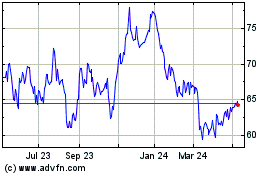This article is being republished as part of our daily
reproduction of WSJ.com articles that also appeared in the U.S.
print edition of The Wall Street Journal (February 8, 2019).
In Brazil case, court documents show the auditor told police he
feared losing business
By Luciana Magalhães and Samantha Pearson
SÃO PAULO -- A safety auditor who inspected a Vale SA
mine-tailings dam that collapsed in January killing at least 150
people told police he felt pressured to attest to its stability,
despite indications it was unsafe, because he feared losing
business with the company, according to court documents seen by The
Wall Street Journal.
Brazilian authorities are trying to pinpoint the causes of the
disaster at the iron-ore mine in the rural town of Brumadinho, the
worst of its kind in more than 50 years, and are investigating
whether Vale was aware of any potential risks to the integrity of
the dam.
The safety auditor, Makoto Namba, a 62-year-old civil engineer
employed by German inspection company TÜV SÜD, told police that
Vale knew there were problems with the dam, according to the court
documents. Mr. Namba said he told Vale that water was leaking into
the reservoir behind the dam, and that its drainage system was
insufficient.
As the world's largest iron ore miner and one of the country's
biggest exporters, Vale wields great influence over Latin America's
largest nation, employing more than 100,000 people. Just as many of
Brumadinho's residents rely on the company for their livelihoods,
the industry's auditors also rely on the company for a large chunk
of their business.
Mr. Namba told police that Vale should have relocated the
canteen and offices on the site as they were directly beneath the
dam and potentially in danger, according to the court
documents.
The mine's canteen and offices, as well as a hotel and nearby
homes, were wiped away when the dam's collapse on Jan. 25 unleashed
a tsunami of mining waste that struck the lunchroom with such force
that bodies were found almost a mile down the valley.
Rescue workers had recovered 150 bodies by late Thursday.
Another 182 people are missing and presumed dead.
Police believe the 280-foot-high dam may have collapsed after
water built up beneath its solid mud surface. Mining experts said
that excess water could have prompted the dam's contents to
suddenly turn to liquid in a process called "liquefaction",
prompting the lava-like mud to burst out.
Investigators said the same process occurred when another mine
part-owned by Vale 80 miles from Brumadinho collapsed in 2015,
killing 19 people.
When TÜV SÜD attested to the dam's safety in a report in
September, it also detailed a number of factors that mining experts
said should have raised red flags about the overall safety of the
dam at Vale, largely related to the dam's drainage and how much
water was in the tailings collected by the dam.
In TÜV SÜD's report, which was reviewed by the Journal, the
auditor recommended that Vale repair damage to drainage systems in
certain parts of the dam. Some of the water-drainage tubes and
channels had been clogged by vegetation or damaged by cows
trampling over the site.
Mr. Namba said he signed off on the safety of the dam on the
promise that Vale would follow TÜV SÜD's recommendations. According
to the court documents, Mr. Namba said that a technical director at
Vale told him, "Is TÜV SÜD going to sign this safety declaration or
not?"
Mr. Namba told police he felt that comment was a "way to
pressure Mr. Namba and TÜV SÜD to sign the safety declaration or
risk losing the contract." Mr. Namba told police he started working
for TÜV SÜD when it acquired a Brazilian consulting firm where he
had worked for two decades.
Vale said that it is cooperating with the authorities and has
provided them with internal documents related to the dam. The
company said it has no record of an increase of water in the dam
and some data indicate a reduction of water.
A person close to the miner said Vale is reluctant to draw
conclusions based only on Mr. Namba's account.
TÜV SÜD said it is deeply saddened by the dam's collapse and it
is carrying out its own investigation into what happened, and
cooperating with the authorities.
Emails exchanged between Vale and TÜV SÜD just days before the
dam collapsed showed that Vale was also aware of potential problems
with the sensors at the dam, according to the documents.
Mr. Namba told police that if those problems with the sensors
were confirmed, and his own son were working at the facility, he
would have called him immediately and told him to flee, according
to the documents.
The Wall Street Journal reported last week that TÜV SÜD worked
as both a consultant and an independent safety evaluator for Vale,
raising questions among experts over potential conflicts of
interest.
Employees of TÜV SÜD acted as consultants on Vale mine closures,
co-authored research reports with the miner, and spoke at
conferences alongside representatives of the Brazilian company.
International industry benchmarks on the management of tailings
dams stress that a safety inspector should be able to demonstrate
independence from a client.
But miners in Brazil have pushed back against these
recommendations, said Joaquim Pimenta de Ávila, a Brazilian
engineer who said he once audited the dam. Miners also frequently
change their auditors, putting extra pressure on inspection firms
to do what they can to hold on to their clients.
--Jeffrey T. Lewis and Paulo Trevisani contributed to this
article.
Write to Luciana Magalhães at Luciana.Magalhaes@wsj.com and
Samantha Pearson at samantha.pearson@wsj.com
(END) Dow Jones Newswires
February 08, 2019 02:47 ET (07:47 GMT)
Copyright (c) 2019 Dow Jones & Company, Inc.
VALE ON (BOV:VALE3)
Historical Stock Chart
From Mar 2024 to Apr 2024

VALE ON (BOV:VALE3)
Historical Stock Chart
From Apr 2023 to Apr 2024
